
The Union-Castle Line was a British shipping line that operated a fleet of passenger liners and cargo ships between Europe and Africa from 1900 to 1977. It was formed from the merger of the Union Line and Castle Shipping Line.
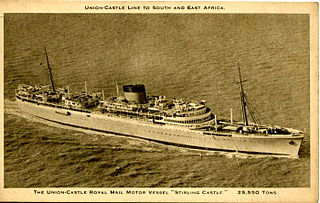
RMMV Stirling Castle was a British ocean liner of the Union-Castle Line built by Harland & Wolff in Belfast for the Southampton to South Africa mail service. She was launched on 15 August 1935 and was the first of two identical sister ships, being joined a few months later by the Athlone Castle.
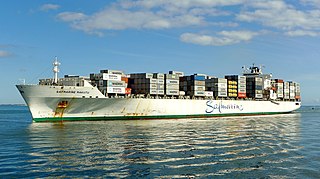
Safmarine, short for South African Marine Corporation, and latterly South African Marine Container Lines, was a South African shipping line, established in 1946, which offered freight transport services with cargo liners and container ships. It was bought by Maersk Line in 1999, and was fully integrated into that company in 2020. It also operated passenger vessels and specialised cargo ships.

RMS Transvaal Castle was a British ocean liner built by John Brown & Company at Clydebank for the Union-Castle Line for their mail service between Southampton and Durban. In 1966 she was sold to the South Africa-based Safmarine and renamed S.A. Vaal for further service on the same route. Following cessation of the service between the UK and South Africa in 1977 the ship was sold to Carnival Cruise Line and rebuilt in Japan as the cruise ship SS Festivale, re-entering service in 1978. In 1996 she was chartered to Dolphin Cruise Line and renamed IslandBreeze. In 1998 the ship was sold to Premier Cruise Line, which renamed her The Big Red Boat III. Following the bankruptcy of Premier Cruise Line in 2000, The Big Red Boat III was laid up until 2003 when she was sold to scrappers in Alang, India. She was renamed The Big Red Boat for her final voyage to the scrapyard.

Amerikanis, formerly Kenya Castle, was a UK-built steam turbine ocean liner that became a Greek-owned cruise ship.

RMS Arundel Castle was a British ocean liner and Royal Mail Ship which entered service in 1921 for the Union-Castle Line. A previous vessel of the same name was built in 1864 by Donald Currie & Co. and sold in 1883, whereupon it was renamed Chittagong. Originally laid down as the Amroth Castle in 1915, building was delayed by the First World War. She was eventually launched on 11 September 1919. She was completed on 8 April 1921 and in 22 April 1921 the ship departed from Southampton on her maiden voyage to Cape Town. During World War 2 she was requisitioned by the Admiralty to serve as a troopship. After the war she resumed passenger service, eventually being scrapped in 1959.

RMMV Capetown Castle was a British passenger liner built by Harland & Wolff at Belfast for the Union-Castle Line's mail service from Southampton to South Africa. She was launched in September 1937 and sailed on her maiden voyage on 29 April 1938.
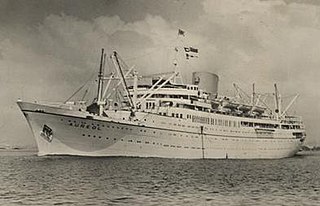
MV Aureol was a mid-sized British ocean liner, originally put into service for Elder Dempster Lines of Liverpool in 1951. She was constructed on the River Clyde in Glasgow by Alexander Stephen and Sons. At 537 feet long and measuring 14,083 gross register tons, Aureol had room for 329 passengers and carried 145 crew. She spent her entire Elder Dempster career on the UK-Lagos passenger cargo service. From 1951 to 1972 she sailed from Liverpool, but closure of the landing stage and the hope of better loadings led to her being transferred to Southampton for the last two years of her service.
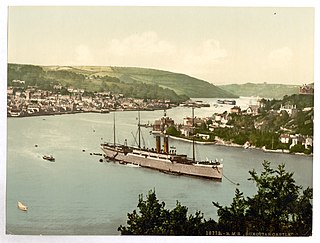
RMS Dunottar Castle was a Royal Mail Ship that went into service with the Castle Line in 1890 on the passenger and mail service between Britain and South Africa. In 1913 the ship was sold to the Royal Mail Steam Packet Company as the Caribbean. After the outbreak of the First World War she served as HMS Caribbean, first as a troop ship and then as an armed merchant cruiser, until she sank in a storm off the Scottish coast on 27 September 1915.

RMS Empress of England was an ocean liner built in 1956-1957 by Vickers-Armstrongs, Newcastle upon Tyne, United Kingdom for the Canadian Pacific Steamships. The ship was launched in 1956; and she undertook her maiden voyage in 1957 and was a near identical sister ship to Empress of Britain.

SS Príncipe Perfeito was a passenger ship built in 1961 by Swan Hunter on the River Tyne. She first entered service for the Companhia Nacional de Navegação, often abbreviated as CNN.

RMS Pendennis Castle was a Royal Mail Ship, passenger and cargo liner operated by the Union-Castle Line. The vessel served the Union-Castle Line from 1959-1976 on a regular route between the UK and South Africa for the Southampton to Las Palmas, Cape Town, Port Elizabeth, East London and Durban "Cape Mail" service. After her withdrawal from service and subsequent sale by the Union-Castle Line in 1976, she was re-named consecutively Ocean Queen, Sinbad, then Sinbad I, however she never returned to commercial service after her Union-Castle Line service and was sold for scrap in 1980.

SS Cap Polonio was a German 20,576 GRT ocean liner that was launched in 1914 and scrapped in 1935. She worked the Hamburg Südamerikanische Dampfschifffahrtsgesellschaft route between Hamburg in Germany and Buenos Aires in Argentina. She was named after Cabo Polonio in Uruguay.

QSMV Dominion Monarch was a UK passenger and refrigerated cargo liner. Her name was a reference to the Dominion of New Zealand. The unusual prefix "QSMV" stood for quadruple-screw motor vessel.
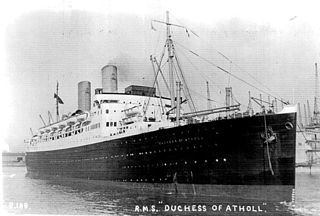
RMS Duchess of Atholl was one of a class of four steam turbine ocean liners built in Glasgow in 1927–29 for Canadian Pacific Steamships Ltd's transatlantic service between Britain and Canada.

RMS Strathmore was an ocean liner and Royal Mail Ship of the Peninsular and Oriental Steam Navigation Company (P&O), the third of five sister ships built for P&O in the "Strath" class. Launched in 1935, she served on the company's route from London to India until 1940, when she was requisitioned for war service as a troop ship, and redesignated as SSStrathmore, until being returned to her owners in 1948. After a long re-fit, she resumed service with P&O from 1949 until 1963, when she was sold to Latsis Lines and renamed Marianna Latsi, then Henrietta Latsi, before being laid up in 1967 and finally scrapped in 1969.
RMS Andes was a 26,689 GRT steam turbine Royal Mail Ship, ocean liner, cruise ship, and the flagship of the Royal Mail Lines fleet. She was the second Royal Mail ship to be named after the South American Andes mountain range. The first RMS Andes was an A-class liner launched in 1913. In 1929 that RMS Andes was converted into a cruise ship and renamed Atlantis.

SS Stratheden was a UK-built steam turbine ocean liner. She spent most of her career with the Peninsular and Oriental Steam Navigation Company, including the Second World War when she served for six years as a troop ship.
Anglo-African was a steam cargo ship built in 1900 by the Short Brothers of Sunderland for Lawther, Latta & Co. of London with intention of operating on their Australian routes. The vessel operated mostly on South America to North America route during her career and was wrecked on one of her regular voyages in January 1909.

RMMV Athlone Castle was a British passenger liner built by Harland & Wolff for the Union-Castle Line's mail service from Southampton to Cape Town, South Africa route. After she was launched on 28 November 1935, she sailed on her maiden voyage on 22 May 1936. She served as a troopship during world war two and in 1965 was scrapped at Kaohsiung.




















